Last Updated on December 9, 2025
In today’s fast-paced world, managing your time effectively is a significant challenge. However, Time Blocking has emerged as a modern productivity technique that stands out for its simplicity and effectiveness. This method involves dividing your day into specific blocks of time dedicated to particular tasks. By doing so, you not only boost your focus but also increase your productivity in both your work and personal life.
This article will delve into the essence of time blocking, highlighting its numerous benefits. It will also provide practical steps to incorporate this method into your daily routine. By adopting efficient planning, you can significantly enhance your productivity, overcome procrastination, and achieve a healthier balance between work and personal life. This, in turn, will help you reach your goals more effectively.
Key Insights
- Time blocking can help avoid interruptions and distractions by scheduling tasks on your calendar.
- This technique may reduce procrastination and make tasks more manageable.
- Time blocking allows for a clearer structure, leading to more focused work periods.
- It helps in setting better boundaries by scheduling tasks intentionally.
- Utilizing time blocking can assist in achieving a healthier work-life balance.
- By encouraging prioritization, time blocking enhances organization and clarity in task management.
- A structured time-blocked approach can lead to smoother transitions between tasks throughout the day.
What is Time Blocking?
Time Blocking is a method designed to boost productivity by dividing your day into focused segments. It turns the traditional to-do list into a more actionable plan by assigning tasks to specific time slots. This helps you focus on key activities without feeling swamped by numerous responsibilities.
Understanding the Concept of Time Blocking
Time Blocking is all about setting aside specific times for different tasks throughout your day. Techniques like traditional time blocking, the Pomodoro technique, and batching help you divide your schedule into manageable parts. This structured method fosters a concentrated work environment, reduces distractions, and supports a flow state.
How Time Blocking Works in Practice
To apply time blocking, begin by planning your day or week and segmenting it into time blocks. For example, dedicate a morning block for email responses and an afternoon block for reports. This method ensures you have set times for tasks, giving each one your undivided attention. Tools like monday.com can also help by visualizing your time allocation and tracking task progress.
By scheduling your tasks directly in your calendar, you avoid relying on to-do lists and gain control over your workload. This approach enhances focus, enabling you to prioritize high-priority tasks effectively. Regularly reviewing and adjusting your schedule will improve your time management skills. For more insights on effective Time Blocking strategies, check out this resource.
The Importance of Effective Time Management
Effective time management is crucial for boosting productivity and achieving personal or professional goals. It’s not just about planning; it’s also about prioritizing tasks effectively. Traditional time management methods often lead to long to-do lists, overwhelming individuals and causing them to overlook crucial tasks.
Defining Time Management and Productivity
Time management involves organizing and planning how you allocate time to different activities. It enables you to work smarter, not harder, thereby enhancing productivity. By setting clear priorities, you can concentrate on what’s truly important. This ensures that vital tasks get the attention they need.
Common Challenges with Traditional Time Management Techniques
Many face hurdles when solely relying on traditional time management methods. These issues frequently surface:
- Overwhelming To-Do Lists: Long lists can stress you out and decrease productivity, making it hard to focus effectively.
- Lack of Control: About 80% of people don’t use a time management system, leading to feelings of losing control over their workload.
- Difficulty in Breaking Down Tasks: Nearly 95% find it hard to split large tasks into smaller, manageable parts, which can lead to procrastination.
- Work-Life Balance Dilemmas: With 86% of individuals struggling to balance work with personal life, satisfaction in both areas can decline.
Switching to a more structured time management approach, like time blocking, can significantly boost your productivity. This method promotes focusing on one task at a time while keeping your schedule clear. It’s essential for maintaining clarity and direction in your workload.
The Benefits of Time Blocking
Time blocking offers a structured approach that boosts productivity and reduces anxiety. It involves setting specific times for tasks, fostering a focused environment. This method aids in completing and prioritizing crucial goals. Psychologist Jordan Peterson notes that such structure enhances efficiency and well-being.
Enhanced Focus and Increased Productivity
Time blocking sharpens focus and boosts productivity. It discourages multitasking, ensuring you focus fully on one task. Research shows that defined time slots lead to higher completion rates and deeper engagement in each task. Time blocking turns your day into a series of purposeful, reducing distractions and improving concentration.
Reduction of Procrastination
This approach helps overcome procrastination by setting clear time slots for projects. It instills a sense of urgency, prompting action. Studies reveal that planning through time blocking increases the likelihood of goal achievement. Scheduled tasks encourage immediate action, preventing last-minute delays.
Improved Task Prioritization
Time blocking promotes reflecting on priorities, highlighting what’s most important. It designates time for high-impact tasks, making your workflow more efficient. This method emphasizes urgent tasks and fosters a mindset focused on achievement. Assessing goals clearly helps you envision your daily activities.
Better Work-Life Balance
Time blocking facilitates a better work-life balance by setting aside time for personal commitments. It includes exercise, leisure, and self-care, creating a balanced routine. This approach helps visualize time use across life areas, enhancing well-being and satisfaction. By prioritizing commitments, you empower your decision-making and reduce stress.
Getting Started with Time Blocking
Starting with Time Blocking requires a series of deliberate steps that can be seamlessly integrated into your daily life. This method, favored by luminaries like Bill Gates and Elon Musk, enables you to organize your time effectively. It minimizes distractions and boosts productivity.
Steps to Implement Time Blocking in Your Routine
To initiate your time blocking journey, follow these essential steps:
- Identify your tasks: Compile a detailed list of all tasks, from professional duties to personal responsibilities.
- Prioritize: Sort tasks by their urgency and significance, capping important tasks at three per day.
- Estimate durations: Assign realistic time frames for each task, acknowledging Parkinson’s Law, which states work expands to fill the time available.
- Block your schedule: Reserve specific time slots for each task on your calendar, ensuring every moment is utilized efficiently.
- Remain flexible: Be prepared to adjust your time blocks as needed. Life’s unpredictability demands flexibility to maintain smooth adaptation.
Tips for Effective Time Allocation
Enhancing your time allocation can significantly elevate your productivity. Keep these tips in mind for optimal time management:
- Know your power hours: Schedule your most demanding tasks during your peak productivity times for superior outcomes.
- Group similar tasks: Consolidate similar activities to reduce cognitive overload and minimize distractions.
- Include downtime: Remember to allocate breaks and relaxation time, as Benjamin Franklin advocated for a balance between work and leisure.
By adopting these strategies, you can begin to experience the advantages of Time Blocking. This structured approach not only clarifies your schedule but also enhances work flow, allowing for deeper focus on essential tasks.
How to Create Your Time Blocked Schedule
Creating a well-structured schedule can revolutionize how you handle your tasks daily. It begins with understanding your productivity patterns and organizing tasks effectively. This approach ensures you utilize your time efficiently and reduces interruptions.
Crafting Your Ideal Daily Schedule
To create an effective daily schedule, start by examining your routine. Identify your most productive hours, usually in the mornings and late afternoons. Use this insight to assign challenging tasks during these periods. Grouping similar tasks reduces interruptions and boosts efficiency.
Consider scheduling content creation when your energy peaks, often early in the week. This strategy enhances focus and leads to superior outcomes.
Utilizing Digital Calendars for Efficient Planning
Digital calendars like Google Calendar or Outlook are essential for a time-blocked schedule. They present your daily schedule in a clear, user-friendly format. These platforms also make it simple to adapt your schedule as needed, accommodating urgent tasks or unexpected meetings.
Setting reminders keeps you on schedule, ensuring focused efforts and minimizing distractions. Using digital calendars simplifies your planning, thereby boosting your productivity.
Integrating Time Blocking into Daily Life
Adopting time blocking into your daily schedule can dramatically boost your productivity and concentration. By synchronizing this strategy with other productivity tools, you develop a comprehensive approach to time management. It’s essential to leverage various tools and strategies to fully benefit from time blocking.
Combining Time Blocking with Other Productivity Methods
Integrating time blocking with techniques like the Pomodoro Technique can revolutionize your workflow. This method allows for focused work periods punctuated by brief breaks, enhancing concentration and reducing fatigue. Such a layered approach helps you:
- Improve focus by switching between work and rest cycles.
- Minimize burnout by scheduling breaks.
- Strike a balance between deep, focused work and routine tasks.
Using Time Tracking for Better Insights
Adding time tracking to your schedule offers deep insights into your time block efficiency. Tools for tracking time expose your productivity patterns, highlighting areas for improvement. By understanding how long tasks take, you can:
- Pinpoint areas for enhancement, boosting focus and efficiency.
- Accurately predict task durations, aiding in better planning.
- Make informed decisions on future time allocations for different tasks.
Common Pitfalls of Time Blocking
Time blocking can be a powerful tool for boosting productivity, but it’s not without its challenges. Identifying these pitfalls early can help you make the most of this method. Understanding your limitations is crucial for overcoming potential issues and refining your approach for better results.
Recognizing and Overcoming Challenges
The planning fallacy often leads people to underestimate task duration, resulting in delays and frustration. To mitigate this, consider scheduling tasks to take twice as long as anticipated. Regularly evaluating your time blocks can help you make necessary adjustments.
- Include buffer times: Leaving a minimum of 15 minutes between tasks provides the necessary flexibility in scheduling to manage unexpected interruptions.
- Schedule lighter workloads on Thursdays and Fridays: These tend to be less productive days, ideal for catching up on incomplete tasks.
- Balance work and break times: Aim to work for about 52 minutes followed by a 17-minute break, optimizing your focus and energy levels.
Maintaining Flexibility in Your Schedule
Flexibility is key for time blocking to succeed. A rigid schedule can lead to burnout or feelings of defeat when unexpected events occur. It’s vital to allow for adjustments and prioritize activities that keep you motivated and engaged. By experimenting with your personal productivity rhythms, you can find the best times for your tasks.
Using digital tools for scheduling can streamline the process. Being open to changes ensures quick adjustments without the clutter of manual planning. A flexible schedule allows you to fully embrace time blocking and reap its benefits.
Time Blocking vs. Time Boxing
Understanding the differences between Time Blocking and Time Boxing is crucial for improving your task management. Both methods aim to increase productivity but serve distinct purposes. Time blocking dedicates specific periods to various tasks, offering a flexible daily schedule. In contrast, time boxing focuses on finishing a task within a set time, promoting intense focus.
Understanding the Differences
Time blocking involves setting aside parts of your day for specific activities, promoting a balanced lifestyle. This approach allows for scheduled breaks, making it suitable for tasks needing both focus and relaxation. Time boxing, however, sets strict limits for single tasks, enhancing focus by eliminating distractions until completion. It’s effective for overcoming procrastination and boosting concentration.
When to Use Each Method
Use time blocking when you have multiple tasks to handle. It’s beneficial for those who prefer a comprehensive view of their day. Conversely, turn to time boxing for tasks requiring deep concentration. Employing these task management techniques can significantly improve productivity and time management skills.
Real-Life Applications of Time Blocking
Time blocking is more than just a theory; it significantly impacts various real-life scenarios. In the workplace, it helps employees by structuring their time for meetings and focused work. This method allows for better task management and boosts productivity by dedicating specific times to projects.
Time Blocking in Professional Settings
Many top professionals, including Elon Musk, use time blocking to streamline their hectic schedules. Musk employs 5-minute blocks to manage his roles across different companies. This technique helps him balance work, family, and personal life efficiently. It also improves decision-making by reducing the need to switch tasks frequently, thus enhancing productivity.
Benefits for Freelancers and Remote Workers
For freelancers and remote workers, time blocking is crucial for handling diverse workloads and client needs. It allows for setting aside time for projects, personal growth, and rest. This method helps avoid underestimating project timelines, a common pitfall known as the planning fallacy. It not only boosts productivity but also supports a better work-life balance, enabling you to focus on both professional and personal goals.








